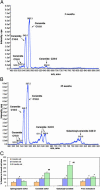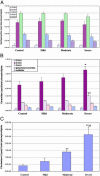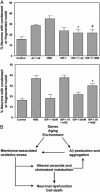Involvement of oxidative stress-induced abnormalities in ceramide and cholesterol metabolism in brain aging and Alzheimer's disease
- PMID: 14970312
- PMCID: PMC357053
- DOI: 10.1073/pnas.0305799101
Involvement of oxidative stress-induced abnormalities in ceramide and cholesterol metabolism in brain aging and Alzheimer's disease
Abstract
Alzheimer's disease (AD) is an age-related disorder characterized by deposition of amyloid beta-peptide (Abeta) and degeneration of neurons in brain regions such as the hippocampus, resulting in progressive cognitive dysfunction. The pathogenesis of AD is tightly linked to Abeta deposition and oxidative stress, but it remains unclear as to how these factors result in neuronal dysfunction and death. We report alterations in sphingolipid and cholesterol metabolism during normal brain aging and in the brains of AD patients that result in accumulation of long-chain ceramides and cholesterol. Membrane-associated oxidative stress occurs in association with the lipid alterations, and exposure of hippocampal neurons to Abeta induces membrane oxidative stress and the accumulation of ceramide species and cholesterol. Treatment of neurons with alpha-tocopherol or an inhibitor of sphingomyelin synthesis prevents accumulation of ceramides and cholesterol and protects them against death induced by Abeta. Our findings suggest a sequence of events in the pathogenesis of AD in which Abeta induces membrane-associated oxidative stress, resulting in perturbed ceramide and cholesterol metabolism which, in turn, triggers a neurodegenerative cascade that leads to clinical disease.
Figures





References
-
- DeKosky, S. T. (2001) Clin. Cornerstone 3, 15–26. - PubMed
-
- Mattson, M. P. (1997) Physiol. Rev. 77, 1081–1132. - PubMed
-
- Smith, J. D. (2000) Ann. Med. 32, 118–127. - PubMed
-
- Puglielli, L., Konopka, G., Pack-Chung, E., Ingano, L. A., Berezovska, O., Hyman, B. T., Chang, T. Y., Tanzi, R. E. & Kovacs, D. M. (2001) Nat. Cell Biol. 3, 905–912. - PubMed
Publication types
MeSH terms
Substances
Grants and funding
LinkOut - more resources
Full Text Sources
Other Literature Sources
Medical

